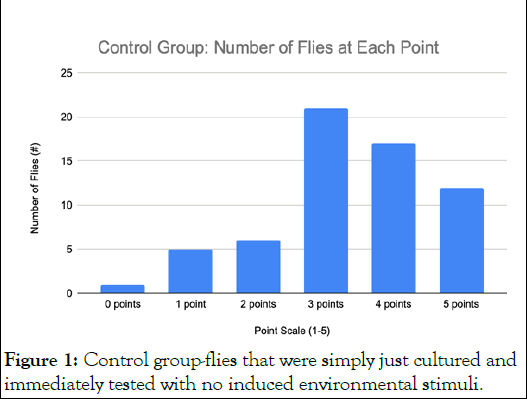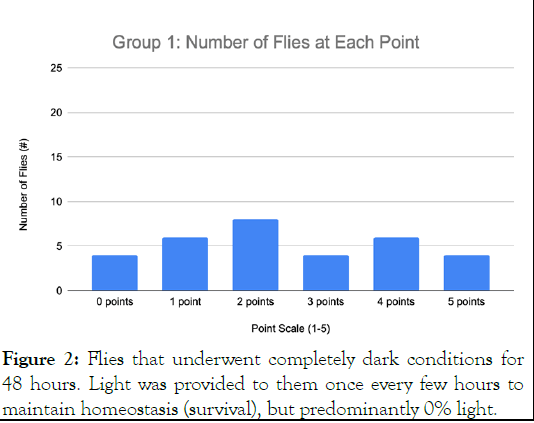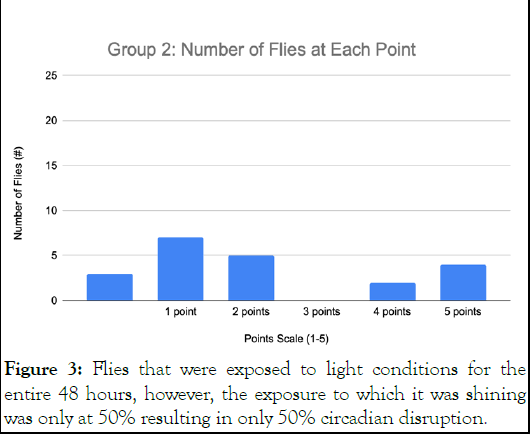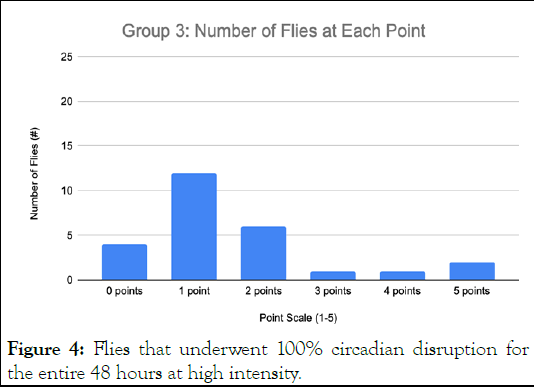Journal of Depression and Anxiety
Open Access
ISSN: 2167-1044
ISSN: 2167-1044
Research Article - (2025)Volume 14, Issue 1
This study investigates the impact of disrupted circadian rhythms on the cognitive function of Drosophila melanogaster. By exposing fruit flies to altered light-dark cycles, we assess changes in learning and memory through behavioral assays. The findings suggest that circadian disruptions negatively affect cognitive performance, highlighting the importance of biological rhythms in neural functioning. This research contributes to understanding how circadian irregularities may influence cognitive processes, with implications for broader biological and health contexts.
Circadian rhythm; Cognitive function; Drosophila melanogaster; Learning; Memory
The idea for how we’re able to function stems from the idea of our circadian variation, which allows humans to execute tasks, comprehend and retain information as efficiently as possible, and stimulate many other functions that are useful in our lives. This day and night cycle runs on some sort of “timer,” hence why you tend to process things slower in the night than that of the morning. In fact, the circadian rhythm has been studied in 3 aspects of psychological processes including attention, working memory and executive functions, which is clearly shown as people tend to work differently in these aspects of life-all based on your circadian development. Moreover, research indicates that patients who undergo disorders have an altered circadian that matches up with their cycle. This phenomena is understandable as psychiatric disorders including trama, dementia and others which can fluctuate with the hormones of the body, ultimately slowing down cognitive development further. The intricate system of the circadian rhythm lies further than that of a sleep schedule; its neurological function and phylogenetic ties to ancient and present day mammals stimulate a difference in growth. The way the “clock” works is like so: In mammals, they are generated in the nucleus of the hypothalamus (yours body’s coordinating center where all senses pass through; releases inhibiting hormones), which in turn allow for our tissues to be spaced throughout the body in all cells and organ types [1]. In simpler terms, it's the brain's ability to receive signals through environmental stimuli that activate hormones and affect your internal/biological function in numerous waysone instance is sleep and metabolism (which can contribute to memory and cognitive information in animals), both of which work simultaneously. One instance that has been studied tying circadian development to changes in physiological development include its increasing risk of bipolar and depression amongst participants. Such multileveled emotion and manic changes was directly influenced by an altered circadian clock and how such complex interaction amongst biochemical, psychological and genetic factors caused a bipolar disorder in people [2]. Taking a deeper look on metabolic production and circadian development, animals have long been the test subject for such tasks as they provide insight into how we humans function. Therefore, a study conducted implied how a disrupted circadian affected metabolic rate of animals bodies significantly. Truly, the use of animal models on genetic disruption has shed new light on mechanisms that link metabolic function and can increase chances of metabolic disease [3]. Ultimately, plenty of research indicates how affected circadian rhythm can deteriorate the mammals mental and biological function as a whole, however, little research has shed light onto the extent to which a certain group of animals, namely fruit flies, are influenced by circadian rhythms subjected to a variety of tests, which is what I plan on investigating.
Based on the background research, I plan on conducting an experiment that evaluates how Drosophila fruit flies navigate through a variety of mazes after being influenced by a disrupted circadian rhythm via environmental stimuli (light exposure). Using previously performed experiments, the data in animal models that have been tested and compared to humans (found similar) could be a representation to my data and see if the research conducted can support any true findings. Much of the mammals studied earlier provide for various levels of internal body temperatures that differ greatly from normal readings [4], hence why performing this experiment will allow me to gain a trusting understanding of how fruit flies' internal bodies work. Ultimately, the idea of sleep deprivation on mental health is already prevalent and well established (as research shows above), however, my experimentation will decipher and take a deep look into how these species of fruit flies are clearly being affected and the results will truly testify it.
Materials
Safety precautions
Ultimately, conducting a fruit flie experimentation regarding mazes has not too many safety concerns, however, there are some things that should be considered. Specifically, make sure to wear any sort of apron, goggles and gloves as they will ensure that the bacteria absorbed from the flies will not contaminate your surroundings or yourself. Also, since we are dealing with jars, which are glassware, having goggles on will provide utmost caution. Finally, disposing of any waste must be done appropriately as glassware should be separated from the rest of the disposables and any sort of disinfectant spray should be used to clean up the working area as fruit flies could possibly contaminate it. Make sure to abide by the instructions given to dispose of the fruit flies accordingly and conduct much of the experiment with care and caution [5].
Fruit fly culturing
Culture your own
a) Subject the fruit flies into a group of 10 jars so they are not clustered together/evenly group them (20 flies per jar, optimizing enough in case some die).
b) Provide each jar with an ample amount of nutrition so they can grow and survive-an apple slice per jar in addition to a few drops of water is enough.
c) Let them grow for a week by providing them with enough nutrients to maximize growth.
d) Monitor their changes by taking pictures and recording observations.
Maze construction
Optimal design
Maze assembly
Y-maze:
Preliminary data
Trial setup
This will wrap up the preliminary set of data and will allow us to move onto the experimental group where we can induce circadian disruption and testify its effects.
Inducing circadian rhythm disruption
Abundance of UV light
Moderate: Still a lot of light but not too invasive in sleep/ mainly throughout the day (10 hours in total). Light level is not highly bright either
Low: Twilight conditions, hardly be used for any sort of purpose/medium levels (5 hours-none of which will be induced within sleep).
Dim: Dark light/next to nothing and equal to light from your phone (3 hour).
Soft/Ambient light: Next to nothing, can be dealt with easily and can possibly allow for extra sleep (1 hour).
Data collection
Start each trial by introducing the fruit flies to the maze. This should be done by one jar at a time so collecting data and keeping track is easier.
For the first batch of flies, release them in the maze with the treat and see if they still are able to get back to where they were to start. Let them do this a few times and record the data as well as take pictures.
Then, with that same group of flies, take out the treat and release them into it once again. See if anything changes. Were they able to learn and go back to the same place? Did anything else happen? Make sure to record any irregularities and derive what they did based on the point system listed in the maze construction specific aim.
Repeat this same procedure with each group of flies from the remaining jars for the maze.
Statistical analysis
Data preparation
Differentiate between data collected between the experimental group and the control group.
After conducting multiple trials for each fly, calculate how well each fly remembered where the food was and how close they got to the location when the food was removed by looking at the data collected using the sectionalized parts of the maze (the 5 point scale).
Any skewed data that is considered an outlier can either be reassessed or completely taken out as human error and confounding factors can always interfere with the results.
Chi-square test
Develop hypotheses: A null hypothesis (no association among groups tested) vs. an alternative hypothesis (effect of IV on DV).
Calculated the expected frequency (what is favorable to occur):

This is all dependent on the table that you develop.
Calculate the Chi-square statistics:

This allows us to look at the differences between both groups based on the expected frequencies.
Find the degrees of freedom: n-1.
Compare the results
Test whether the data is statistically significant by comparing it to the null hypothesis (usually 0.05).
In order to actually perform the chi-square test, you can use some sort of statistical software that will compare the p-value that was a result of your chi-square test.
Calculated chi-square value>critical chi-square value, your null hypothesis is rejected which means that there is statistically significance between the group associated with affected Circadian rhythm and cognitive ability in the maze (overlap error bars if you are making a bar graph/histogram).
Calculated chi-square value
Success rate can be measured based on the foundations of a binary model (not entirely).
The maze will have a certain criteria that has to be met in order to earn the points.
Ethical disposing and clean-up process
As we are dealing with some glassware, make sure you are wearing appropriate accessories including gloves, goggles and maybe an apron/lab coat.
For the disposal of the fruit flies, follow instructions given by your instructor in order to maintain proper ethical guidelines. Make sure not to touch with bare hands as the bacteria that we hold can possibly contaminate them or they can affect us.
For the maze, slowly dismantle it starting with the walls first and then the floors. Make sure to put them in a separate disposable box, not just the normal trash.
Clean up the lab area that you worked in by using any disinfectant spray which could wipe away any of the bacteria left behind.
Anything that can be reused again must be thoroughly cleaned and rinsed before setting aside for a further experiment so it does not skew results for further replications.
Any glassware should be extinguished cautiously and into a designated disposal container issued by your instructor. Handle such items with care and make sure to label any other containers so they are secured safely.
Confirm that the lab space is cleaned up appropriately and ready for further experiments by any other groups
Data analysis
As clearly depicted by the results in the data Table 1 and Figures 1-4, there was significant change in cognitive memory for flies that were more associated with circadian disruption rather than those that were more slightly affected; however, all groups underwent drastic change in comparison to the control group, who were simply just cultured Drosophila melanogaster fruit.
| # of flies per sector | Point scale | |||||
|---|---|---|---|---|---|---|
| 0 points | 1 point | 2 points | 3 points | 4 points | 5 points | |
| Control | 1 | 5 | 6 | 21 | 17 | 12 |
| Group 1 | 4 | 6 | 8 | 4 | 6 | 4 |
| Group 2 | 3 | 7 | 5 | 0 | 2 | 4 |
| Group 3 | 4 | 12 | 6 | 1 | 1 | 2 |
Table 1: The overall data of control groups.

Figure 1: Control group-flies that were simply just cultured and immediately tested with no induced environmental stimuli.

Figure 2: Flies that underwent completely dark conditions for 48 hours. Light was provided to them once every few hours to maintain homeostasis (survival), but predominantly 0% light.

Figure 3: Flies that were exposed to light conditions for the entire 48 hours, however, the exposure to which it was shining was only at 50% resulting in only 50% circadian disruption.

Figure 4: Flies that underwent 100% circadian disruption for the entire 48 hours at high intensity.
Flies that were inflicted with no environmental stimuli. To start, the control groups (Group 0) trends were quite natural and expected as a majority of them were directly engaged by the presence of the melon, earning them a higher score on the point scale. There was no stimulus intruding on their travel, hence why they were most likely to find the food source so well. After about 5 minutes, predominantly every fly that was released was scavenging through the melon as they completed the task, which was mainly as a comparison. Next, the first group tested underwent 0% circadian disruption flies who survived under dark conditions for nearly 2 days [6].
These flies looked more languid than the control group and many of which died. Nonetheless, when they were released into the maze, the results were surprising: the distribution of flies varied greatly, with 1/5 of them hovering near the starting point, ½ of them blockading near the divider that was established to segregate both arms of the maze and a few of them actually pursuing the arm with no fruit earning them 0 points. However, what was even more surprising was that the group that was inflicted with circadian disruption in the form of no light source at all (Group 1), did see nearly 20 flies on the path of travel to the melon, 3 of which were actually able to eat the food source. This data shows that although change can be attributed to the control group and group 1, there is a common overlap that consists of flies that are still subjected to the melon, which supports the notion that circadian rhythm was hardly affected by this group and their cognitive memory is still somewhat predominant [7].
However, this changes for groups 2 and 3. As shown by the data, in these groups, there was a great shift in standard deviation as the cluster of the flies shifted from a weighted mean of 3.355 points in the control group to 2.143 and 1.577 in groups 2 and 3, respectively. Further, even though it was classified that there was not much change with the control group and group 1, this is simply false as the weighted mean for the flies in group 1 was 2.438, approximately a whole point deficit less. This shift in standard deviation away from the mean shows that the flies that underwent more circadian disruption tended to experience less cognitive capabilities as they were less likely to navigate back to the melon than before. Further, after conducting a t-test for a difference in means between the control group and each of the other groups, it was determined that there was a statistically significant difference in the weighted average means of the samples
Possible data gaps
To take notice of, as shown by the analytical results in the table, there is a significant difference between the number of flies in the control groups and that of groups 1 and especially 2 and 3. Going from nearly 70 flies to approximately 20 flies resembles a common trend in that many flies were not able to survive in such conditions, regardless of how much nutrition that was given to them. Because there wasn’t an equal sample size for control groups and groups 1, 2, and 3, it offered a hindered data that is not as accurate to tests among groups. For example, since the control group had many more flies, the standard error decreases, however, this is not the case for the experimental ones because there is more standard error. It is simply illogical to compare different sample sizes and a primary reason for the excessive death of flies was due to excess radiant temperatures. As noticed, the number of flies in the culture decreases as the groups receives more disruption-with an exception for group 2. This also supports their lack of energy due to circadian disruption. Instead, more precaution regarding time intervals that the flies undergo such conditions should be examined much more closely, as 48 hours seemed to drain them much more, while also leading to drastic deaths. Also, the idea of testing cognitive memory regarding such mazes and fruit flies was not very thorough and the mechanism for testing memory could be done much more efficiently. This can be seen via a radial arm maze that guarantees more precise results, more fly groups to offer a wider range of data points and a more precise numeric system that is favorable to all flies (with the current model that was made, some flies that were in the middle of two points led to an estimation; this would not be the case for an alternative numbering system that could provide real/empirical data points). Finally, the time that the flies were left in the maze varied greatly from group to group as some groups had a total of 10 minutes while others only had 5 minutes. This does not provide for the same opportunity for the flies to reach the melon so the mark at which they were tracked is not entirely dependent on their drive for food but more on how much time there were given; this simply negates the objective of this experiment and instead, a constant time should be reinforced so they all undergo the same opportunity. Nonetheless, the mechanisms that were used for this fruit fly experimentation did provide data that reached a conclusion asserting that cognitive development is highly dependent on the circadian rhythm.
With the information that has been collected regarding fruit flies learning and memory along with environmental factors, this information can provide deeper insight into behavioral studies that are associated with other mammals. Because flies tend to accumulate many similar internal and biological characteristics that are favorable to other organisms like butterflies and even follow a similar biological clock as humans, studying behavioral studies which are common amongst the flies can similarly be attributed to those of humans. Though some of these practices could be considered unethical and are not capable of being performed on humans, simply studying human behavior through other forms of circadian disruptions like diets or artificial supplements like caffeine could provide a similar insight. Behavioral studies consist of a wide sector that is very common among organisms and psychologists like John Watson have long studied the overlapping behaviors between humans and animals. By uncovering a small portion of it through fruit fly experimentation on their circadian rhythm, understanding human behavior in very similar ways can be attributed (following ethical principles). Motivation and hunger are subcategories that can be derived from the fruit fly experiment and are the main two principles that can further be studied with results from the flies' trends. As seen, flies are motivated through incentives, which simultaneously drive hunger hormones that are innate within their body; however, after draining of energy, is this drive and motivation lost, or are they simply incapable of making it to the end? For some flies in group 3, they were capable of making it throughout the maze to achieve basic needs, however, this is not the same for the majority. Motivation and hunger are two key phenomena that are linked to behavior studies in mammals and by understanding what drove some flies in the experiment conducted, studying the insights of motivation and hunger in other organisms including humans can unlock many new results.
Taking such experimentation further (if working with flies again) would drive a study more prone to focusing on what causes flies to acquire such food, if there are any certain foods that are more prone to driving flies and how bad does a lack of food drive them to seek for such? All of these questions do not require a disruption in circadian rhythm but can include certain stressors/obstacles that further test flies. Motivation is an integral part of animal psychology and by integrating fruit flies into such experimentation, new insight can be gained for further research
[Crossref] [Google Scholar] [PubMed]
[Crossref] [Google Scholar] [PubMed]
[Crossref] [Google Scholar] [PubMed]
[Crossref] [Google Scholar] [PubMed]
[Crossref] [Google Scholar] [PubMed]
[Crossref] [Google Scholar] [PubMed]
[Crossref] [Google Scholar] [PubMed]
Citation: Kulkarni A (2025) The Effect of a Disrupted Circadian Rhythm on the Cognitive Function of Drosophila Fruit Flies Independent Science Research. J Dep Anxiety. 14:564.
Received: 18-Mar-2024, Manuscript No. JDA-24-30230; Editor assigned: 20-Mar-2024, Pre QC No. JDA-24-30230 (PQ); Reviewed: 03-Apr-2024, QC No. JDA-24-30230; Revised: 05-Mar-2025, Manuscript No. JDA-24-30230 (R); Published: 12-Mar-2025 , DOI: 10.35248/2167-1044.25.14.564
Copyright: © 2025 Kulkarni A. This is an open-access article distributed under the terms of the Creative Commons Attribution License, which permits unrestricted use, distribution, and reproduction in any medium, provided the original author and source are credited.